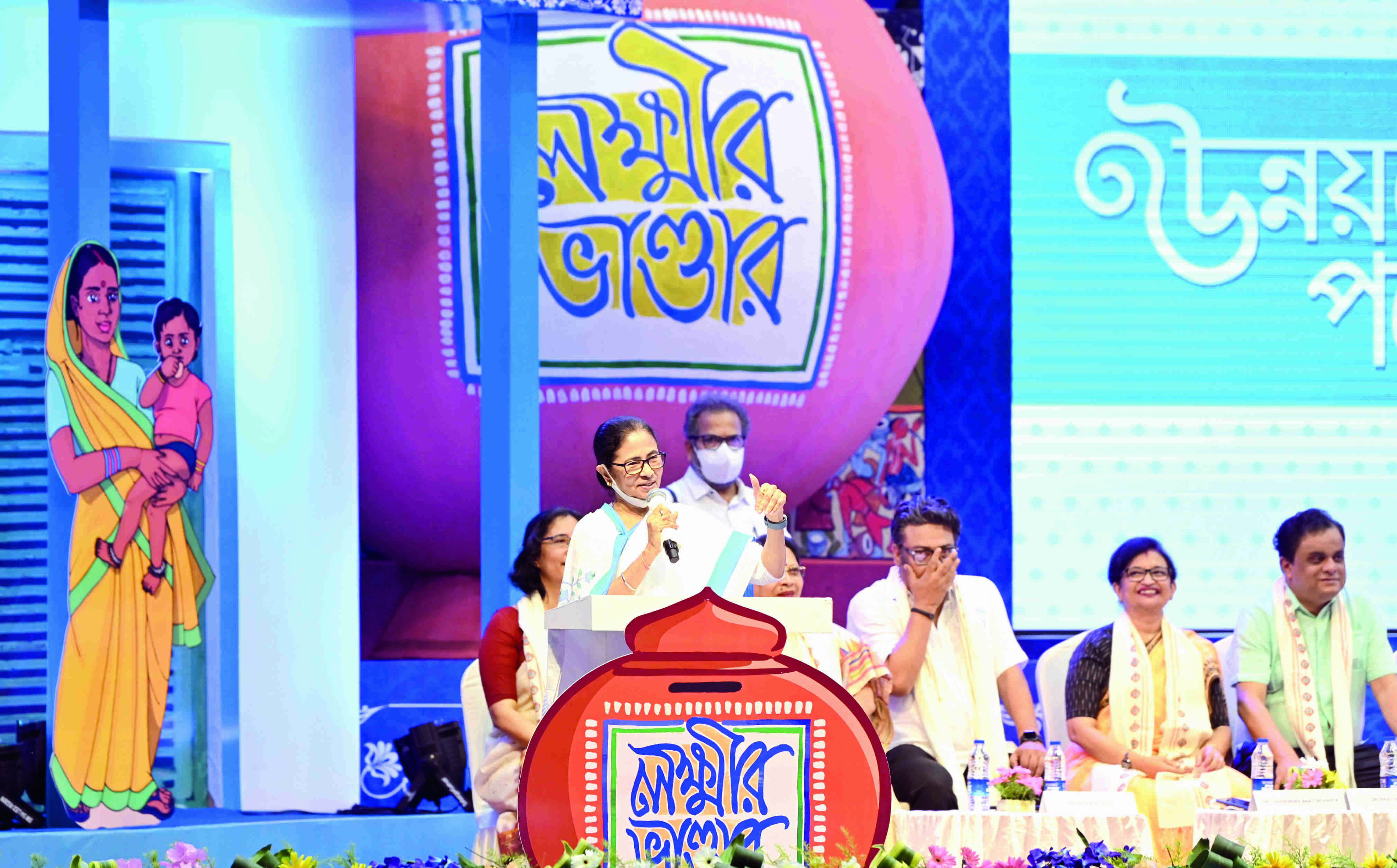'State's GDP grows to Rs 17.13L crore from Rs 4.51L cr in 10 yrs'

kolkata: Within a decade of being in power in Bengal, the Mamata Banerjee-led government improved the Gross State Domestic Product fourfold from Rs 4.51 lakh crore in 2011 to Rs 17.13 lakh crore in 2022. Bengal's budget, meanwhile, has tripled from Rs 84,804 crore in 2011 to Rs 2,60,629 crore in 2022.
Chief Minister Mamata Banerjee on Thursday commemorated the one-year anniversary of the third Trinamool Congress-led state government by distributing Lakshmir Bhandar cheques to another 20 lakh women across the state.
"The women of Bengal are our Lakshmi. Without them, schools, hospitals, and homes wouldn't run. Women of Bengal are taking the lead and showing us the way forward,"Banerjee added.
The state government has achieved great success in empowering women.
Over 1.53 crore women have benefited from Lakshmir Bhandar scheme in the state with direct cash transfers of Rs 500 to women in the General category and Rs 1,000 to SC and ST female heads of families.
While first rear of term 3 of TMC trended on the top spot across the nation, the Chief Minister—who is also the Trinamool Congress supremo—lauded Bengal's growth under the TMC government. "Unlike other political parties, which only bank on destructive agenda and divisive politics, Trinamool Congress does what its says," Banerjee added.
At the Bengal Global Business Summit 2022, investment proposals worth Rs 3,42,375 crore has been assured, which is expected to generate over 4 lakh jobs across the state.
Over 5 crore applicants have been benefitted from the state government's Duare Sarkar outreach programme. Duare Sarkar camps are organised twice a year at the gram Panchayat/municipal-ward level, to ensure doorstep delivery of government schemes.
Bengal government has also disbursed monthly pensions of Rs 1,000 to over 12 lakh senior citizens belonging to marginalised communities under various social welfare schemes of the state government, such as Jai Bangla-Jai Johar and Tapashili Bandhu, said Trinamool in a statement.
It also stated the state government has also built over 32 lakh rural houses under the 'Banglar Awas Yojna', which aims at providing a pucca house with minimum size of 25 square metre floor area. Over 10 crore people have benefitted from 'Khadya Sathi', a digital ration card scheme that ensures delivery of rice and wheat at Rs 2 per kg to nearly 90 per cent of the state's population.
The 'Duare Ration' scheme, meanwhile, has benefited over 5 crore people by providing ration at their doorstep.
As per the TMC statement a total of 6.5 lakh women have been granted 'Rupashree', a one-time financial assistance of Rs 25,000 given to financially distressed families at the time of their daughter's marriage. With over 29 lakh women employed across the MSME sector in Bengal, the state ranks the highest in this category among all other Indian states.
TMC has announced a two-week long programme throughout the state to celebrate the formation of its government for the third successive term. Regarding the infrastructure development in Bengal, at the Deucha Pachami coal project, over Rs 35,000 crore will be invested for improved electricity and employment generation. A deep-sea port at Tajpur, is likely to generate over 25,000 jobs with a proposed investment of Rs 15,000 crore.
Another highly significant project for the state government is the 'Jungal Sundari Karmanagari' at Purulia, which is expected to attract an investment of over Rs 70,000 crore and generate employment for approximately 1.5 lakh people, the statement said.
Bengal has attracted IT firms at its Silicon Valley in New Town. Twenty four companies allotted 79 acres of land, attracting greater investment. Infosys has started construction of its campus and Wipro is likely to start construction in New Town in September.
West Bengal ranks second in the MSME sector, employing 1.35 crore people across 88.67 lakh units.
The state also ranks second in generation of mandays under Mahatma Gandhi National Rural Employment Guarantee Act, with 36.42 crore mandays generated in 2021-22.
Bengal has also been ranked as the number 1 state by the Reserve Bank of India on Net Per Capita Income Growth in 2020-21.
The state's net per capita income witnessed a 7.1 per cent growth from Rs 1,13,163 in 2019-20 to Rs 1,21,267 in 2020-21. The number of factories in Bengal, meanwhile, increased from 8,322 in 2010 to 9,534 (15 per cent increase) in 2020, with average factory worker earnings rising from Rs 1.3 lakh to Rs 2.3 lakh, a 77 per cent increase, read the statement.
In 2021, the state government laid the foundation for 6 new medical colleges; increasing the capacity of MBBS seats by 600. Over 2,300 Suswasthya Kendras have also been providing tele-medicine services to residents under the 'Swasthya Ingit' scheme.
Swasthya Sathi has covered a total of 2 crore families, while the budgetary expenditure on healthcare has increased by 80.17 per cent from 2011 to 2022. In the education front, Bengal recorded the lowest school drop-out rate in India as per the ASER report 2020.
A total of 3,546 students have received low interest loans under the Student Credit Card scheme of the state government, while over 76.26 lakh girl students have been benefited under the 'Kanyashree Prakalpa', an internationally recognised scheme of the state government.



